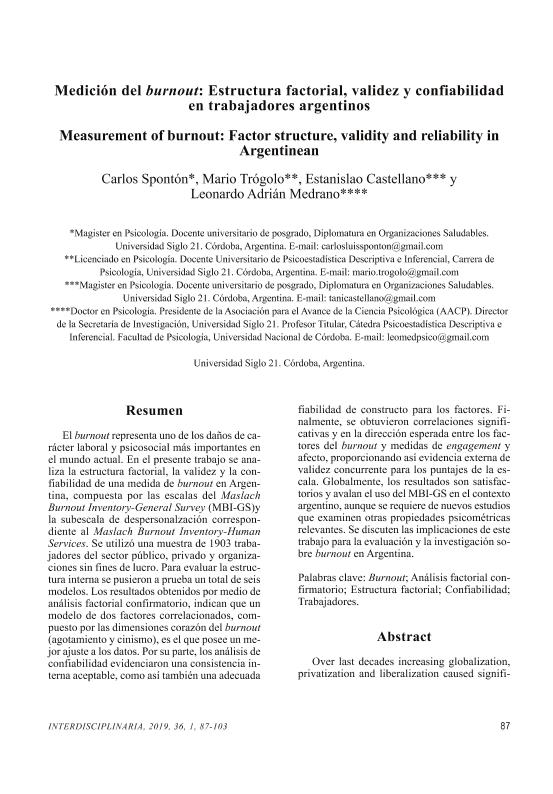Artículo
El burnout representa uno de los daños de carácter laboral y psicosocial más importantes en el mundo actual. En el presente trabajo se analiza la estructura factorial, la validez y la confiabilidad de una medida de burnout en Argentina, compuesta por las escalas del Maslach Burnout Inventory-General Survey (MBI-GS) y la subescala de despersonalzación correspondiente al Maslach Burnout Inventory-Human Services. Se utilizó una muestra de 1903 trabajadores del sector público, privado y organizaciones sin fines de lucro. Para evaluar la estructura interna se pusieron a prueba un total de seis modelos. Los resultados obtenidos por medio de análisis factorial confirmatorio, indican que un modelo de dos factores correlacionados, compuesto por las dimensiones corazón del burnout (agotamiento y cinismo), es el que posee un mejor ajuste a los datos. Por su parte, los análisis de confiabilidad evidenciaron una consistencia interna aceptable, como así también una adecuada fiabilidad de constructo para los factores. Finalmente, se obtuvieron correlaciones significativas y en la dirección esperada entre los factores del burnout y medidas de engagement y afecto, proporcionando así evidencia externa de validez concurrente para los puntajes de la escala. Globalmente, los resultados son satisfactorios y avalan el uso del MBI-GS en el contexto argentino, aunque se requiere de nuevos estudios que examinen otras propiedades psicométricas relevantes. Se discuten las implicaciones de este trabajo para la evaluación y la investigación sobre burnout en Argentina. Over last decades increasing globalization,privatization and liberalization caused significant changes at work, including demands of learning new skills, the need to adopt new types of works, higher pressure of productivity and quality of work, and time pressure, which, in turn, increased rapidly work stress-related phenomenon such as burnout. To date, burnout has become one of the most active research areas in Occupational Health Psychology, spreading attention from researchers, practitioners and policymakers. Despite thousands of investigations on burnout, there is currently an on going debate surrounding its conceptualization and measurement, particularly the dimensions of burnout syndrome. In addition, although several studies have been conducted in Argentina, no study so far has demonstrated adequate psychometric properties of any measure of burnout that supports it use. Consequently, the current studysought to examine the internal structure, validityand reliability of a composite measure of bur-nout compounded by the three scales from Mas-lach Burnout Inventory-General Survey (MBI-GS) and the depersonalization subscale from Maslach Burnout Inventory-Human Services. A sample of 1903 Argentinean workers from public, private and non-profit sectors participated in the study. To ascertain the more appropriate factor structure of burnout several competing models were tested, specifically: (M1) A one-factor model that assumes burnout as a one-dimensional construct; (M2) A two-factor correlated model with only exhaustion and cynicism (core model); (M3) A two-factor correlated model with exhaustion and cynicism combined into a latent variable and professional inefficacy into another; (M4) A three-factor correlated model with cynicism and depersonalization collapsed into one factor (mental distance), exhaustion and professional inefficacy; (M5) A three-factor correlated model including exhaustion, cynicism and depersonalization; and (M6) A four-factor correlated model with exhaustion, cynicism, depersonalization and professional inefficacy as latent variables. Confirmatory factor analyses indicated that the two-factor correlated model including the core dimensions of burnout (exhaustion and cynicism) provided the best fit to the data. Reliability analyses demonstrated that both exhaustion and cynicism have good internal consistency and adequate construct reliability, which coefficient value supper .70. As expected, exhaustion and cynicism were significantly and negatively related with engagement and positive affect, and positively related with negative affect, supporting for concurrent validity. Overall, these results are in agreement with recent studies suggesting a more parsimonious conceptualization of burnout that includes only exhaustion and cynicism as more appropriate. We did not find support for professional inefficacy as a component of burnout. Thus, in accordance with some researchers, we suggest that professional inefficacy might bemore appropriately conceptualized as a predictor or a consequence –or even both- rather than as a component of burnout. However, due to cross- sectional design used in this study, longitudinal study to test such contention is needed. Furthermore, the current findings support the use of exhaustion and cynicism subscales of MBI-GS for assessing burnout in Argentina, making available a useful tool for practitioners and researchers interested in prevention and treatment of job burnout. Nonetheless, it would be worthwhile to conduct further research in order to examine additional relevant psychometric properties such as test-retest reliability and predictive, convergent and discriminant validity. In addition, it would be important for future research to test the invariance of the two-factor model across different occupations, which might strengthen the findings obtained herein and provide evidence that support the validity of conclusions based on comparison between occupational groups. Finally, future investigation should also investigate the robustness of MBI-GS against social desirability bias.
Medición del burnout: Estructura factorial, validez y confiabilidad en trabajadores argentinos
Título:
Measurement of burnout: Factor structure, validity and reliability in Argentinean
Fecha de publicación:
06/2019
Editorial:
Consejo Nacional de Investigaciones Científicas y Técnicas. Centro Interamericano de Investigaciones Psicológicas y Ciencias Afines; Consejo Nacional de Investigaciones Científicas y Técnicas. Centro Interdisciplinario de Investigaciones en Psicología Matemática y Experimental
Revista:
Interdisciplinaria
ISSN:
1668-7027
Idioma:
Español
Tipo de recurso:
Artículo publicado
Clasificación temática:
Resumen
Archivos asociados
Licencia
Identificadores
Colecciones
Articulos(CCT - CORDOBA)
Articulos de CTRO.CIENTIFICO TECNOL.CONICET - CORDOBA
Articulos de CTRO.CIENTIFICO TECNOL.CONICET - CORDOBA
Citación
Spontón, Carlos Luis; Trógolo, Mario Alberto; Castellano, Estanislao; Medrano, Leonardo Adrian; Medición del burnout: Estructura factorial, validez y confiabilidad en trabajadores argentinos; Consejo Nacional de Investigaciones Científicas y Técnicas. Centro Interamericano de Investigaciones Psicológicas y Ciencias Afines; Consejo Nacional de Investigaciones Científicas y Técnicas. Centro Interdisciplinario de Investigaciones en Psicología Matemática y Experimental; Interdisciplinaria; 36; 1; 6-2019; 87-103
Compartir




